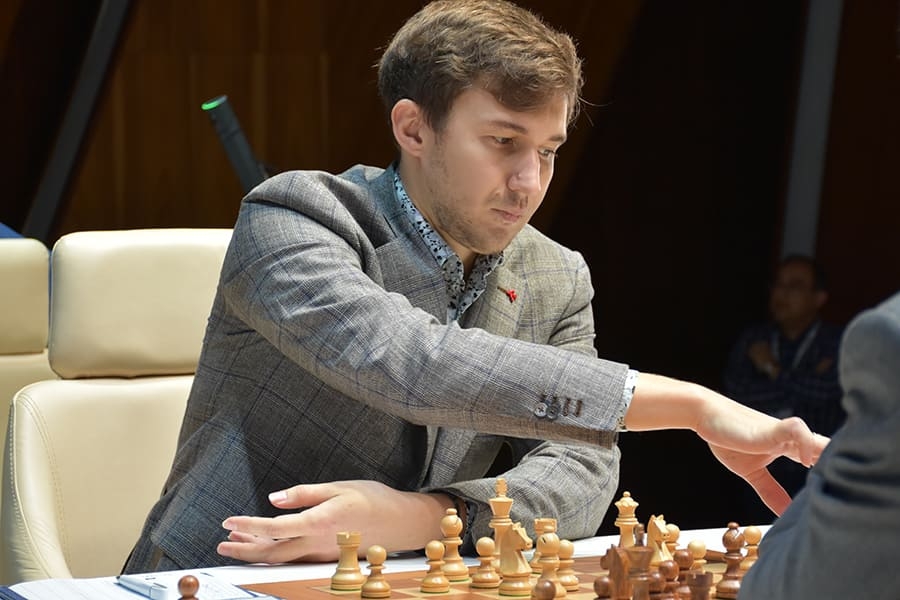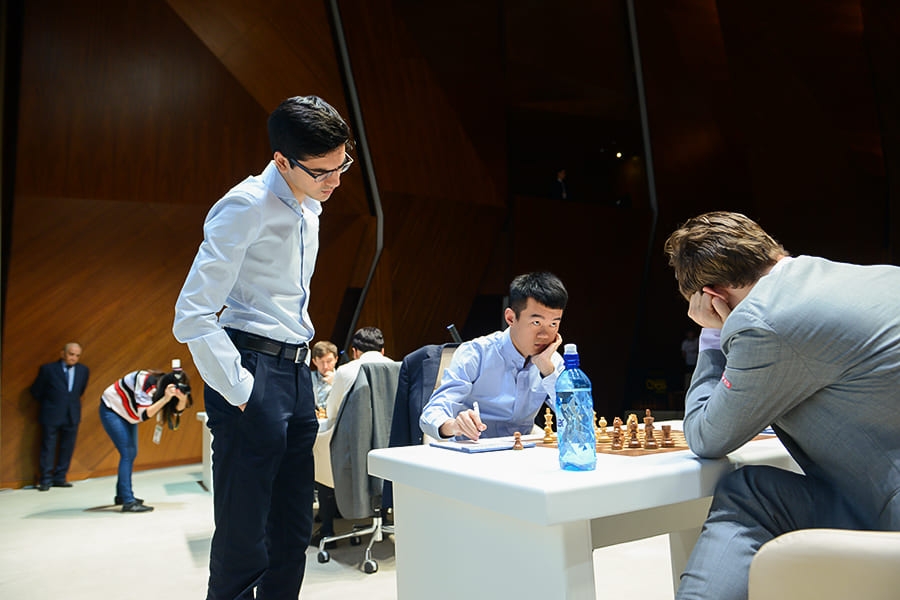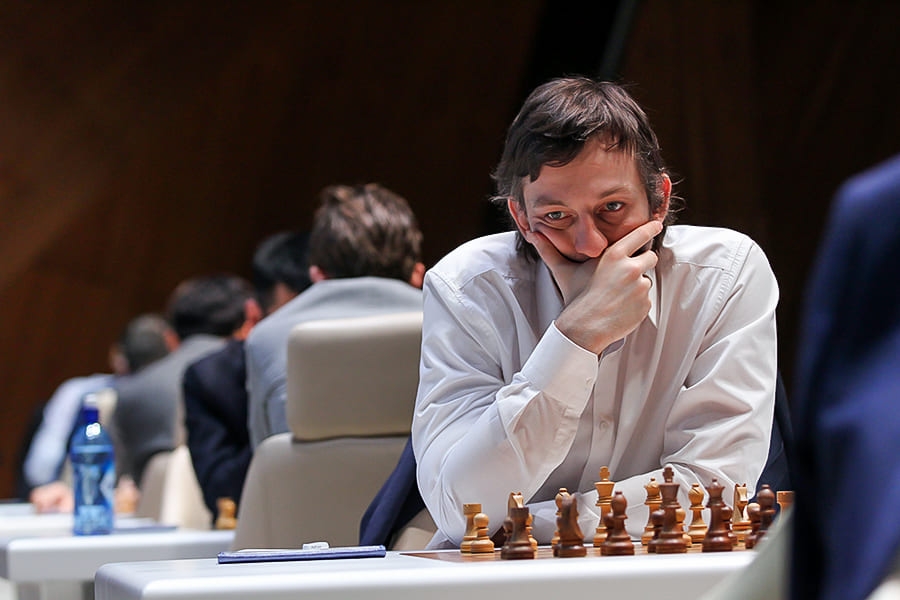


About ten or so years ago, seeing two elite players delving into a theoretical line well into the middlegame was a common sight. Nowadays, it is all about early deviations and getting playable albeit not superior positions with both colours. The 'Magnus effect', we might call it. In Shamkir's sixth round, however, we got to see a blast from the past, as Sergey Karjakin and Vishy Anand played no less than thirty moves of theory!

During the first phase of the games... | Photo: Official site
Until move 12, the players repeated a line that had already not worked for Anand in round two of this same tournament — Carlsen had gotten the better of Vishy after, much like today, getting a slight pull in an endgame. Apparently, this is a variation Vishy had as a main equalising weapon with Black for this tournament, however, as he and Karjakin followed Aronian v Caruana, from the 2018 London GCT final, until move 30.
Sergey had blitzed out all but one of his moves until this point, while Vishy had taken his time about seven times so far. In this position, Aronian had played 31.♖xf4 and further simplifications had led to a 46-move draw. That was a rapid game in a highly tense knockout tournament, however — Karjakin now had all the time in the world to look for the slightest of chances against Anand.
Sergey needed less than ten seconds to play 31.c5 and in the next five moves the endgame reached its defining position after some exchanges:
Without rooks on the board, Black's a-pawn might be considered a trump, but with all four rooks still alive it is rather a weakness. Also, the black king's position is slightly weakened, so White can combine threats against these two weak points to make something out of the seemingly arid position.
And that is precisely what Sergey did, starting with 36.♖a6. The Russian put patient, stubborn pressure on Anand's position until gaining the h-pawn:
Vishy did not want to continue defending after 52.♖exh5 and resigned for a second time in this tournament.
GM Daniel Fernandez took a closer look at the game:

Will Vishy keep trying out this line in the future? | Photo: Official site
Two players who made a name for themselves with uncompromising play on both sides of the board were the protagonists of the other decisive game of round six. Veselin Topalov had the white pieces and faced a classical Ruy Lopez put up by Shakhriyar Mamedyarov. The players did not go for any sideline, with White playing d3 or something similar, and confronted the usual complex manoeuvring middlegames that have been frequently played in the Spanish throughout the years.
Come move 18, Veselin needed 21 minutes to decide on how to keep going:
With so many pieces on the board, White has plenty of ways to go forward — he could play 18.♕e2 or 18.♕b3, for example. Instead, Topalov chose the quiet 18.♖b1, which in fact was the novelty of the game. Another case of a game going deep down the theoretical road. The battle of manoeuvres continued until Shak faltered on move 29:
Feel free to try your own variations on the diagram above
All sorts of tactics are in the air, with the f6-bishop attacked twice and the e4-rook ready to move and launch a discovered attack against the white queen. It is no wonder, therefore, that Mamedyarov missed something in his calculations. The correct way to go was to protect the bishop with 29...♛e7, while Shak's 29...♛c5 gave way to a forcing continuation that favoured White.
The game continued 30.♖dc1 ♜c4 31.♕d1 (a key retreating move) ♞e4 32.♗xc4 bxc4 33.♖xc4.
Black actually resigned here, despite only being an exchange down and having an extra pawn. Mamedyarov must have realised that all the initiative is on White's side and there is no point in being duly outplayed by a first-class player. 1-0.
.jpg)
Veselin is on an even score | Photo: Official site
The top game of the day in terms of rating — in fact, the highest possible combined rating of the tournament — was Ding Liren v Magnus Carlsen. The World Champion played the Gruenfeld and deviated from a recent Leko v Mamedyarov game on move 13. When the queens left the board, it is true that White is the only one capable of putting pressure, but nonetheless it is hard to imagine Magnus losing a position like this in a classical game:
Carlsen immediately freed up his position and accepted it was time to simply defend with 25...e5. Ding Liren looked for chances but eventually had to acknowledge the inevitable and signed the peace treaty.

Giri will play Carlsen in round seven | Photo: Official site
Anish Giri and David Navara played the shortest game of the day, as they found nothing better than a triple repetition after 26 moves. Alexander Grischuk and Teimour Radjabov, on the other hand, started taking considerable time off their clocks from move 7. Nonetheless, Grischuk could not provoke Radjabov to break his all-draws streak in Shamkir, as the point was split after 40 moves.
Click or tap the second game to switch
Karjakin has two games with Black in the remaining three rounds, while Carlsen will play twice with White. However, the only 'white game' for Sergey is his penultimate round encounter against the World Champion.

Grischuk is one of six players on 3/6 | Photo: Official site
| Rank | Name | Rtg | FED | Pts |
| 1 | Sergey Karjakin | 2753 | RUS | 4 |
| Magnus Carlsen | 2845 | NOR | 4 | |
| 3 | Alexander Grischuk | 2771 | RUS | 3 |
| Teimour Radjabov | 2756 | AZE | 3 | |
| Viswanathan Anand | 2779 | IND | 3 | |
| David Navara | 2739 | CZE | 3 | |
| Ding Liren | 2812 | CHN | 3 | |
| Veselin Topalov | 2740 | BUL | 3 | |
| 9 | Anish Giri | 2797 | NED | 2 |
| Shakhriyar Mamedyarov | 2790 | AZE | 2 |
Commentary by Jeroen van den Berg, Silvio Danailov and Sarkhan Gashimov